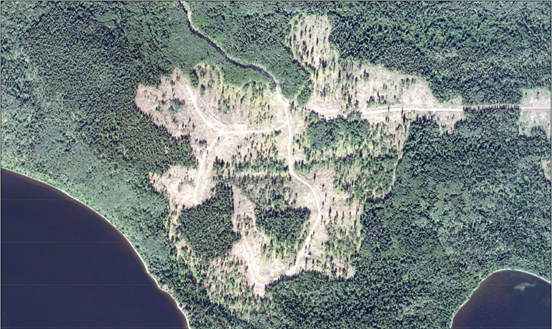 The JPRF is a working forest, and as such, derives the majority of its funding from log sales. This provides an opportunity to integrate the lessons learned from research into forest harvesting plans (and in doing so create other research opportunities). The block above demonstrates principles of strategic harvesting with a focus on retaining important wildlife habitat features, the intent to make this habitat functional during these early successional stages post-harvest. In this block, three wildlife tree patches (WTPs) have been retained to maintain wildlife values within the block boundaries. These protect a mineral lick, representative conifer types provide buffering for a bear den, and hardwood types that maintain deciduous characteristics important to many passerine bird species. In addition, one external WTP is added to protect potential fisher denning habitat. Post-harvest, strategic placement of coarse woody debris (CWD) piles connect the WTPs providing sheltered movement corridors for small mammals (mice, voles, etc) and small furbearers (marten and weasels) until crown closure of the reforested crop trees is restored. In addition, individual mature tree retention in identified harvest areas was retained to provide habitat elements for birds and small furbearers, such as perching and nesting habitat, snags and downed wood into the next rotation. Mature deciduous stems and patches of advanced conifer regeneration are maintained to provide in-block diversity. Where occurring, large diameter Douglas fir on wind protected sites and mature hardwoods are retained to provide for short and long term habitat values. Retention of single-trees in the lakeshore management zone protects the lakeshore buffer the lake. Access management is another element of a wildlife strategy, de-activating the road through tank trap installation and digging up the road bed to reduce traffic and hunting pressures post-harvest. Extensive monitoring has been conducted post-harvest to evaluate the effectiveness of our treatments.
The JPRF is a working forest, and as such, derives the majority of its funding from log sales. This provides an opportunity to integrate the lessons learned from research into forest harvesting plans (and in doing so create other research opportunities). The block above demonstrates principles of strategic harvesting with a focus on retaining important wildlife habitat features, the intent to make this habitat functional during these early successional stages post-harvest. In this block, three wildlife tree patches (WTPs) have been retained to maintain wildlife values within the block boundaries. These protect a mineral lick, representative conifer types provide buffering for a bear den, and hardwood types that maintain deciduous characteristics important to many passerine bird species. In addition, one external WTP is added to protect potential fisher denning habitat. Post-harvest, strategic placement of coarse woody debris (CWD) piles connect the WTPs providing sheltered movement corridors for small mammals (mice, voles, etc) and small furbearers (marten and weasels) until crown closure of the reforested crop trees is restored. In addition, individual mature tree retention in identified harvest areas was retained to provide habitat elements for birds and small furbearers, such as perching and nesting habitat, snags and downed wood into the next rotation. Mature deciduous stems and patches of advanced conifer regeneration are maintained to provide in-block diversity. Where occurring, large diameter Douglas fir on wind protected sites and mature hardwoods are retained to provide for short and long term habitat values. Retention of single-trees in the lakeshore management zone protects the lakeshore buffer the lake. Access management is another element of a wildlife strategy, de-activating the road through tank trap installation and digging up the road bed to reduce traffic and hunting pressures post-harvest. Extensive monitoring has been conducted post-harvest to evaluate the effectiveness of our treatments.

 Respect for the People
Respect for the People